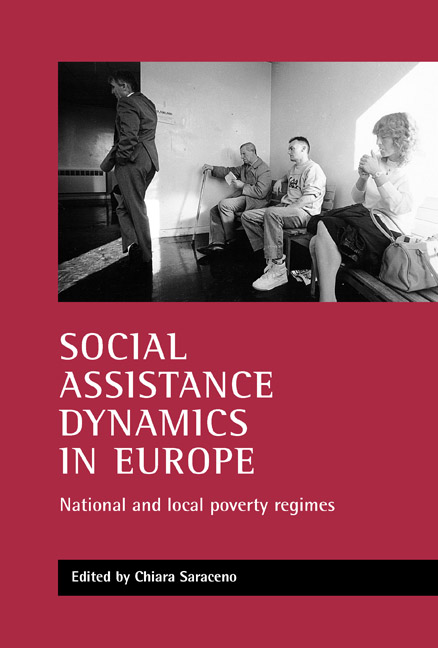Book contents
- Frontmatter
- Contents
- List of figures and tables
- Acknowledgements
- Notes on contributors
- one Introduction: exploring social assistance dynamics
- two Cities as local systems
- three Income support measures for the poor in European cities
- four Why some people are more likely to be on social assistance than others
- five Paths through (and out of) social assistance
- six Deconstructing the myth of welfare dependence
- References
- Appendix Institutional frameworks of income support policies in 13 European cities
- Index
four - Why some people are more likely to be on social assistance than others
Published online by Cambridge University Press: 20 January 2022
- Frontmatter
- Contents
- List of figures and tables
- Acknowledgements
- Notes on contributors
- one Introduction: exploring social assistance dynamics
- two Cities as local systems
- three Income support measures for the poor in European cities
- four Why some people are more likely to be on social assistance than others
- five Paths through (and out of) social assistance
- six Deconstructing the myth of welfare dependence
- References
- Appendix Institutional frameworks of income support policies in 13 European cities
- Index
Summary
A medium range approach
Are some categories of people more likely to be on benefits because they are really more needy? Or is it because the entitlement structure privileges them as a group? It is not easy to answer these questions, as it requires a large amount of information and the consideration of many aspects. In order to give a tentative answer, we need to pull together the issues discussed in Chapters Two and Three of this book: the way in which the local context produces vulnerability and poverty, and the way in which the problem is conceived and tackled at the national and local level. We intend to examine in particular the role of the institutional mechanisms: how they work and how they influence the process of becoming a beneficiary of social assistance.
In order to understand this process, we have to consider the main dimensions that influence the experience of poverty and downward social mobility, which are: (a) the socioeconomic context (including demographic changes), (b) the social network of the potential claimant, and (c) his or her personal capabilities. These dimensions, together with the institutional design, interact with one another to define the degrees of social vulnerability and the risk of becoming poor (and hence the risk of being on social assistance). Of course, the same interaction also defines the set of resources and opportunities that people may use to escape poverty. This chapter, however, focuses on the paths into social assistance and highlights how the contextual driving factors (described in Chapter Two) are transformed by the institutional setting (described in Chapter Three) into socially defined conditions of need of income support.
Figure 4.1 shows how the main dimensions interact with one another. We are aware that at this stage the resulting picture is approximate and does not take into account the full range of complex interactions between these dimensions. Nevertheless, it allows us to appreciate that the vulnerable groups ‘produced’ by the interaction between a given population and its socioeconomic context are not necessarily in a condition of economic need per se. This need emerges through a further selection process involving the institutional dimension, which is at the core of our explanation. The institutional dimension structures people’s life course by defining how public (and partly also private) resources are – or should be – allocated in relation to the risks emerging during critical status passages in life.
- Type
- Chapter
- Information
- Social Assistance Dynamics in EuropeNational and Local Poverty Regimes, pp. 127 - 172Publisher: Bristol University PressPrint publication year: 2002



